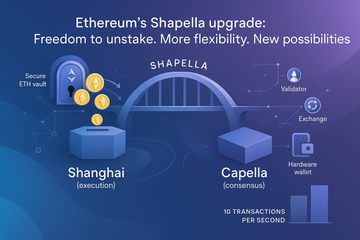If you’ve hung around the crypto scene for any length of time, you’ll know Ethereum isn’t just a household name—it’s practically the backbone of decentralized finance. But until not so long ago, if you staked your ETH, well, your coins were pretty much locked up, as good as sealed in a digital vault. Enter the Shapella fork, a mouthful of a term that’s as important as it sounds. Let’s unravel what the Shapella fork really is, why it got everyone from validators to casual holders buzzing, and how it’s set to change the rhythm of Ethereum staking.
Meet Shapella: Two Upgrades Walk Into a Blockchain
It may sound like a character from a sci-fi novel, but Shapella is actually the catchy nickname folks gave to the simultaneous rollout of two massive Ethereum upgrades: Shanghai and Capella. These didn’t just drop on a whim—they were the result of months of developer brainpower, heated debates, and, let’s be real, a whole lot of coffee-fueled coding sessions.
The headline feature? Users could finally withdraw their staked ETH. Until then, validators who’d committed their coins to keep the network humming were stuck in a waiting game, unable to access or move their assets (Ledger Academy). So when’s this all go down? Drumroll: April 12, 2023. Mark that date if you’re the sentimental type; it’s up there with the Merge as a step-change moment for Ethereum.
Shanghai and Capella: A Blockchain Double Act
Here’s where things get technical—but don’t worry, I’ll keep it breezy. Shanghai tackles what’s called the “execution layer.” Think of it as Ethereum’s front-of-house, handling transactions and making sure smart contracts don’t throw a tantrum. Capella, on the flipside, operates behind the curtain in the “consensus layer,” ensuring everyone agrees about what’s happening on the blockchain (like the most meticulous referee you’ve ever met).
- Shanghai (Execution Layer): This upgrade beefed up transaction efficiency—imagine a busy city street suddenly getting a green wave of traffic lights—and gave developers and users a smoother ride overall.
- Capella (Consensus Layer): Focused on the ins-and-outs of Proof-of-Stake, this part of the upgrade polished how validators confirm transactions and helped streamline how the two layers talk to each other (Tangem).
When you stitch both together, it’s like synchronizing the heart and the head of Ethereum—a network that not only keeps the numbers straight but does so efficiently and with a whole lot more flexibility.
The Big Deal: Unstaking Finally Arrives
Picture this: you’ve lent your favorite mug to a friend who promises to return it when they’re “done with it.” Weeks turn into months, and you start wondering if you’ll ever see it again. That’s what staking felt like for early Ethereum stakers—only their mug was ETH, and there was no clear return date. With Shapella, Ethereum finally let people claim their staked ETH back—no more indefinite waiting, no more uncertainty (CoinDesk).
And believe me, this was more than just a nice-to-have. Opening the doors to withdrawals gave stakers confidence—staking ETH started to feel less like a black hole and more like a flexible, living part of the Ethereum ecosystem.
But Is It All Sunshine and Rainbows?
Now, you might ask, “Did people rush to cash out and crash the ETH price overnight?” Turns out, not quite. Yes, some holders took profits (who can blame them?), but most seemed content to leave their coins working for them. It’s sort of like parking your savings in a high-yield account—you want access, but you’re in no hurry to liquidate every time the wind changes direction (U.Today).
Still, there’s one elephant still munching in the corner: Ethereum’s transaction speeds. Even after Shapella, we’re looking at about 10 transactions per second. Compare that to Visa—let’s just say it’s not quite ready to run every coffee purchase on the globe. But, hey, Rome wasn’t built in a day, and Ethereum’s ambitious roadmap has plenty more twists ahead.
How the Shapella Fork Actually Works Under the Hood
Diving just a smidge deeper, the fork kicked in at “epoch 194,048” (if you’re a stickler for detail), and validators had to update both their consensus and execution layer software to stay plugged into the network.
Ethereum’s devs didn’t just trust things to luck—they upped bug bounties for any sharp-eyed hackers who could spot vulnerabilities. That’s a reminder of the cat-and-mouse dynamic between developers, hackers, and the folks keeping the blockchain secure. If you’re a hardware wallet user—say, you keep your ETH in a Ledger or Trezor—you’ll have noticed these companies quickly pushed firmware updates post-fork. Their aim? Keeping your private keys safe, no matter what the network changes throw your way.
What’s Next? More Upgrades, More Possibilities
Unstaking was just the beginning. With Shapella behind us, Ethereum is gearing up for even bigger moves (Proto-Danksharding, any takers?). They’re chasing better scalability and—let’s hope—transaction fees that won’t make your eyes water. Honestly, in crypto there’s always another fork, upgrade, or proposal brewing just beneath the surface.
If you’re new to the space, all these upgrades can start to feel overwhelming. My advice? Pick up a hardware wallet like Ledger or Trezor, keep an eye on what Ethereum’s devs are cooking up, and remember: the real power of crypto isn’t just the tech—it’s the community figuring it out together, one block at a time.
Final Thoughts: Shapella Fork in the Bigger Picture
It’s rare that a single upgrade changes the way millions interact with a blockchain, but Shapella did just that. From stakers now able to sleep easier to exchanges and wallet makers spinning up new features, its echoes are still felt across the crypto world. Will it go down as the pivotal moment, or just the first of many? Time (and the blockchain) will tell. For now, Shapella stands as a testament to Ethereum’s commitment to evolve—and to the peculiar, passionate dance between cutting-edge tech and human trust.











